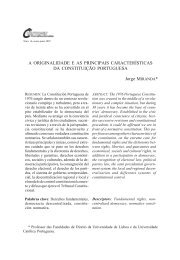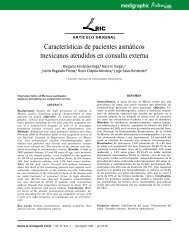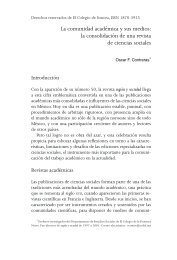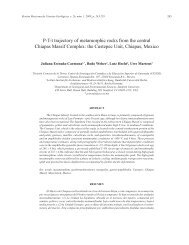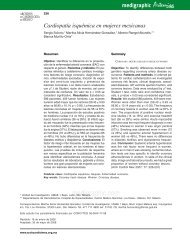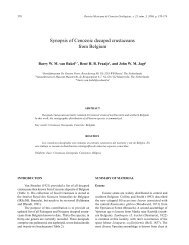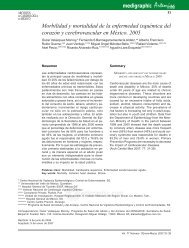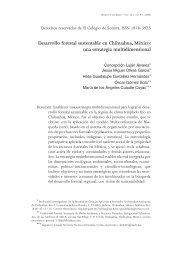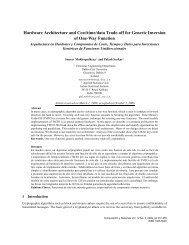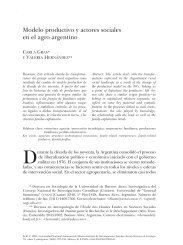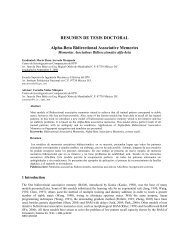tidal heating - Instituto de AstronomÃa - UNAM
tidal heating - Instituto de AstronomÃa - UNAM
tidal heating - Instituto de AstronomÃa - UNAM
Create successful ePaper yourself
Turn your PDF publications into a flip-book with our unique Google optimized e-Paper software.
Revista Mexicana <strong>de</strong> Astronomía y Astrofísica, 43, 89–94 (2007)<br />
TIDAL HEATING: A RESTRICTED THREE BODY PROBLEM<br />
INVESTIGATION OF THE SPITZER AND WEINBERG APPROXIMATIONS<br />
Fi<strong>de</strong>l Cruz and Luis A. Aguilar<br />
<strong>Instituto</strong> <strong>de</strong> Astronomía<br />
Universidad Nacional Autónoma <strong>de</strong> México, Ensenada, B. C., Mexico<br />
Received 2005 September 13; accepted 2006 October 10<br />
© Copyright 2007: <strong>Instituto</strong> <strong>de</strong> Astronomía, Universidad Nacional Autónoma <strong>de</strong> México<br />
RESUMEN<br />
Estudiamos el calentamiento por fuerzas <strong>de</strong> marea <strong>de</strong> cúmulos globulares utilizando<br />
el problema restringido <strong>de</strong> tres cuerpos. Nuestros resultados concuerdan<br />
más con la aproximación <strong>de</strong> Spitzer en el caso adiabático que con la <strong>de</strong> Gnedin y<br />
Ostriker para la aproximación <strong>de</strong> Weinberg. De estos resultados concluimos que la<br />
aproximación <strong>de</strong> Spitzer es válida para cúmulos en órbitas <strong>de</strong> alta excentricidad.<br />
Encontramos que un escalamiento lineal <strong>de</strong>l calentamiento <strong>de</strong>spués <strong>de</strong> un choque<br />
<strong>de</strong> marea subestima el efecto que se mi<strong>de</strong> <strong>de</strong>spués <strong>de</strong> varios choques.<br />
ABSTRACT<br />
We study the <strong>tidal</strong> <strong>heating</strong> of globular clusters using the restricted three<br />
body approximation. Our results are more consistent with the Spitzer correction for<br />
adiabaticity than with the Gnedin and Ostriker formula for the Weinberg correction.<br />
From these results we conclu<strong>de</strong> that the Spitzer approximation is valid for clusters<br />
in orbits with high eccentricity. We find that a simple linear scaling of the effect<br />
after one <strong>tidal</strong> shock greatly un<strong>de</strong>restimates the actual effect after repeated shocks.<br />
Key Words: CELESTIAL MECHANICS — GLOBULAR CLUSTERS:<br />
GENERAL — METHODS: NUMERICAL — STELLAR<br />
DYNAMICS<br />
1. INTRODUCTION<br />
Contrary to what one may conclu<strong>de</strong> from their<br />
isolated appeareance in the sky, globular clusters are<br />
shaped to a great extent by the galactic environment<br />
in which they move (O<strong>de</strong>nkirchen et al. 2003). The<br />
gravitational <strong>tidal</strong> field of the galaxy, in particular,<br />
enhances evaporation of stars and limits their spatial<br />
extent (Spitzer 1987).<br />
In many studies of the effect of the environment<br />
on globular clusters, the three–body approximation<br />
has been an important tool and a substantial number<br />
of important results have been obtained with it. For<br />
example, Hénon (1970), found that retrogra<strong>de</strong> orbits<br />
of test particles are more stable than direct orbits, in<br />
the Hill’s limiting case of the restricted three body<br />
problem. Jefferys (1976) confirmed this result for<br />
the case of a Plummer mo<strong>de</strong>l for the cluster potential<br />
and studied the <strong>de</strong>gree of flattening in globular<br />
clusters produced by the galactic <strong>tidal</strong> field. Innanen<br />
(1979) studied the role of the Coriolis acceleration in<br />
stabilizing retrogra<strong>de</strong> orbits and <strong>de</strong>termined the relative<br />
sizes of <strong>tidal</strong> radii for stars in retrogra<strong>de</strong> and<br />
direct orbits as a function fo the orbital eccentricity<br />
of the cluster.<br />
Another important effect of the <strong>tidal</strong> field is the<br />
energy input produced by its time variation, when<br />
the cluster moves along an elongated orbit, or crosses<br />
the galactic disk. Ostriker, Spitzer, & Chevalier<br />
(1972) pioneered the study of these, so called, <strong>tidal</strong><br />
shocks, for the case of galactic disk crossings. More<br />
recently, Chernoff, Kochanek, & Shapiro (1986) inclu<strong>de</strong>d<br />
this effect in a very thorough investigation of<br />
<strong>de</strong>struction processes that ero<strong>de</strong> the population of<br />
globular clusters in our galaxy.<br />
In most studies of globular cluster <strong>de</strong>struction to<br />
date, <strong>tidal</strong> <strong>heating</strong> has been mo<strong>de</strong>led using an approximation<br />
introduced by Spitzer (1958). This approximation<br />
corrects the result obtained in the impulsive<br />
limit for adiabatic effects introduced when<br />
a finite, non-zero interaction time is consi<strong>de</strong>red.<br />
Spitzer’s approximation mo<strong>de</strong>ls the motion of stars<br />
within a perturbed stellar system as forced one-<br />
89
90 CRUZ & AGUILAR<br />
© Copyright 2007: <strong>Instituto</strong> <strong>de</strong> Astronomía, Universidad Nacional Autónoma <strong>de</strong> México<br />
dimensional harmonic oscilators, the forcing term<br />
being the external <strong>tidal</strong> field. In his original calculation,<br />
Spitzer computed the change in binding energy<br />
for stars insi<strong>de</strong> a stellar cluster due to a passing perturbing<br />
mass. He found that the energy input into<br />
the stellar system <strong>de</strong>cays exponentially as a function<br />
of the ratio of the perturbation time to the orbital<br />
period of the star, being maximum at the cluster’s<br />
edge and quickly approaching zero toward its center.<br />
Aguilar, Hut and Ostriker (1988 hereafter AHO)<br />
used this approximation to compute the <strong>tidal</strong> <strong>heating</strong><br />
of the globular clusters in our Galaxy due to<br />
the galactic bulge. They estimated that the current<br />
<strong>de</strong>ath rate is ∼ 0.5 clusters per billion years.<br />
More recently, Weinberg (1994) reviewed the<br />
original Spitzer approximation and introduced a refinement<br />
that proved crucial: he removed the one<strong>de</strong>gree<br />
of freedom constraint from the approximation.<br />
Adding extra <strong>de</strong>grees of freedom changes qualitatively<br />
this problem: the perturbation can resonate<br />
with linear combinations of the basic frequencies of<br />
the stars along the various <strong>de</strong>grees of freedom, resulting<br />
in enhanced <strong>heating</strong>. Contrary to the Spitzer exponential<br />
<strong>de</strong>pen<strong>de</strong>nce, Weinberg found a power law<br />
behavior that <strong>de</strong>creases with <strong>de</strong>creasing radial position<br />
within the cluster, resulting in a more important<br />
<strong>tidal</strong> <strong>heating</strong>. Gnedin and Ostriker (1997, hereafter<br />
GO) incorporated the Weinberg revision in their reanalysis<br />
of the AHO investigation of cluster <strong>de</strong>struction<br />
rates. They found a <strong>de</strong>struction rate 2 to 5<br />
times higher than the result of AHO. This discrepancy<br />
arises from most <strong>de</strong>tailed mo<strong>de</strong>ling of cluster<br />
dynamics with the Fokker-Planck calculation.<br />
We propose to study with a simple mo<strong>de</strong>l the<br />
adiabatic corrections of Spitzer and Weinberg, using<br />
a set of three-body experiments to verify the validity<br />
of this approximations for <strong>tidal</strong> <strong>heating</strong> within<br />
the context of globular cluster <strong>de</strong>struction. This approximation<br />
does not inclu<strong>de</strong> self-gravity of cluster<br />
stars and its virialization after cluster shock, that<br />
has a very important effect on the energy distribution<br />
(Gnedin & Ostriker 1999). However, a direct<br />
comparison of this approximations with this simple<br />
mo<strong>de</strong>l study will give us a better comprehension of<br />
<strong>tidal</strong> shocks. In §2 we briefly review the Spitzer and<br />
Weinberg approximations. In §3 we <strong>de</strong>scribe the numerical<br />
experiments that we ma<strong>de</strong>. Results of our<br />
numerical simulation and their comparison with the<br />
Spitzer and Weinberg approximations are presented<br />
in §4 and the implications of our results for studies<br />
of <strong>tidal</strong> <strong>heating</strong> of globular clusters are presented in<br />
§5.<br />
2. THE ANALYTICAL APPROXIMATIONS<br />
Spitzer consi<strong>de</strong>red a point mass (the star insi<strong>de</strong><br />
the cluster) moving within a one-dimensional harmonic<br />
potential (the cluster) and subject to an external<br />
force produced by a point mass perturber moving<br />
at uniform speed along a straight path (the galaxy).<br />
He solved the equations of motion using the variation<br />
of coefficients method and found that the change in<br />
energy is given by:<br />
∆E = 1 ( ) 2GMp<br />
3 vp 2 2r 2 η S (β) , (1)<br />
where G is the gravitational constant, M p is the perturber’s<br />
mass, v is the relative velocity between the<br />
perturber and the star, p is the minimum distance<br />
between them and r is the orbital radius of the star.<br />
Spitzer’s correction for adiabaticity η S is given by,<br />
η S (β) = 1 2 [L x(β) + L y (β) + L z (β)] , (2)<br />
here the L i are linear combinations of modified<br />
Bessel functions (Spitzer 1958). The argument β,<br />
is called the adiabatic parameter and it is proportional<br />
to the ratio of the perturbation time to the<br />
period of the star:<br />
β ≡ 2ω sp<br />
v<br />
, (3)<br />
where ω s is the orbital frequency of the star.<br />
Weinberg has argued that the adiabatic mo<strong>de</strong>l<br />
used in the Spitzer approximation is highly artificial.<br />
A one-dimensional oscillator is unrealistic even for a<br />
star in orbit in a spherical potential: the orbits are<br />
planar with radial and azimuthal frequencies. The<br />
presence of various <strong>de</strong>grees of freedom changes the<br />
problem in a non-trivial way. Each <strong>de</strong>gree of freedom<br />
introduces its own frequency and, for the perturbation<br />
to be adiabatic, its associated frequency<br />
must be small not only compared to each in<strong>de</strong>pen<strong>de</strong>nt<br />
frequency, but to all integer linear combinations<br />
of them. Even if the perturbation occurs slowly compared<br />
to each <strong>de</strong>gree of freedom taken in<strong>de</strong>pen<strong>de</strong>ntly,<br />
there may be still be a resonance that pumps energy<br />
into the system at a rate not predicted by the onedimensional<br />
mo<strong>de</strong>l.<br />
Weinberg’s correction for eq(1) has been approximated<br />
analytically by GO as:<br />
η W (β) =<br />
) −3/2 (1 + β2<br />
, (4)<br />
4<br />
where β is given by equation 3 above. Both adiabatic<br />
corrections (equations 2 and 4) approach 1
TIDAL HEATING 91<br />
© Copyright 2007: <strong>Instituto</strong> <strong>de</strong> Astronomía, Universidad Nacional Autónoma <strong>de</strong> México<br />
(the impulsive limit) for β −→ 0, and <strong>de</strong>cay to zero<br />
for large values of it (adiabatic limit), although η S<br />
shrinks exponentially while η W does so as a power<br />
law.<br />
AHO consi<strong>de</strong>red two additional corrections: One<br />
for a perturber with an exten<strong>de</strong>d mass distribution<br />
and another for the cluster orbital eccentricity. For<br />
comparison with our numerical experiments, it is<br />
only the second correction that is relevant, as we<br />
consi<strong>de</strong>r only point masses. In this case, AHO’s second<br />
correction (their equation 11) becomes<br />
λ(e) =<br />
[ (1 ) ] 3 2<br />
− e<br />
− 1 , (5)<br />
1 + e<br />
where λ is a multiplicative factor that must be incorporated<br />
in equation 1. Its value increases with<br />
orbital eccentricity and in this case, p is set equal to<br />
the perigalacticon distance.<br />
3. THE NUMERICAL EXPERIMENTS<br />
We have ma<strong>de</strong> a series of three-body experiments<br />
to verify the validity of the Spitzer and Weinberg corrections<br />
for adiabaticity, for stars in globular clusters<br />
subject to the <strong>tidal</strong> <strong>heating</strong> of the galactic bulge.<br />
We mo<strong>de</strong>l the galactic bulge and the cluster as point<br />
masses in orbit around each other. We choose a system<br />
of units such the the gravitational constant and<br />
the cluster mass are equal to unity, while the cluster<br />
perigalacticon is equal to 400. In these units, the<br />
galactic bulge has a mass equal to 10 4 . We use this<br />
value as it is similar to the one used by AHO and<br />
GO.<br />
Each experiment is <strong>de</strong>fined by the cluster orbit<br />
eccentricity (e =0.00, 0.25, 0.50, 0.75) with the same<br />
perigalacticon, as we <strong>de</strong>fine above. For each experiment<br />
we consi<strong>de</strong>r an ensemble of test particles moving<br />
initially on circular orbits around the cluster, at<br />
various spatial orientations and with different initial<br />
phases. A test particle orbital plane is <strong>de</strong>fined by<br />
two angles: We have used a 4 × 6 uniform mesh for<br />
them. For each orbital plane, we consi<strong>de</strong>r 40 initial<br />
phases, and for each, we consi<strong>de</strong>r two senses of rotation<br />
around the cluster center to <strong>de</strong>fine direct and<br />
retrogra<strong>de</strong> orbits. Additionally, we have consi<strong>de</strong>red<br />
100 initial orbital sizes on each orbital plane, logarithmically<br />
spaced in the range r = 3.16 to 10.0 in<br />
our units; these correspond to a range of adiabatic<br />
parameter of β = 28.4 to 5.0, for the circular cluster<br />
orbit case. This results in an ensemble of 192,000<br />
test particles for each experiment.<br />
As a gui<strong>de</strong> in interpreting these experiments, we<br />
note that if we adopt a mass of 5 × 10 5 M ⊙ for the<br />
cluster and 2 kpc for its perigalacticon the corresponding<br />
apogalactica are 3.3, 6 and 14 kpc. The<br />
galactic bulge has a mass of 5×10 9 M ⊙ and the range<br />
of radial distances for the stars within the cluster<br />
that we consi<strong>de</strong>r is 16 to 50 pc. The theoretical <strong>tidal</strong><br />
radius (Innanen, Harris, & Webbink 1983) for a cluster<br />
in circular orbit is 49 pc in this case. In our units<br />
the <strong>tidal</strong> radius corresponds to ≈ 9.6.<br />
The orbits are integrated using a Burlisch-Stoer<br />
integrator (Press et al. 1992) in a double precision<br />
FORTRAN co<strong>de</strong>. In or<strong>de</strong>r to <strong>de</strong>termine the accuracy<br />
of this co<strong>de</strong> we verified the Jacobi energy conservation<br />
for 10 cluster periods for the e = 0 case, and<br />
found to be good to to one part in 10 16 per timestep<br />
or better, which corresponds to 1/100 of the test<br />
particle period.<br />
We compute the binding energy of the stars with<br />
respect to the cluster as follows;<br />
E s = 1 2 v2 cs − M c<br />
r cs<br />
, (6)<br />
where v cs is the velocity of the star with respect to<br />
the cluster, M c the cluster mass, and r cs the distance<br />
between cluster and corresponding star.<br />
We compute the average <strong>heating</strong> for all the stars<br />
with the same initial radius as follows,<br />
< ∆E cs >= 1 ∑N s<br />
(E i − E<br />
N<br />
0) i , (7)<br />
s<br />
i=1<br />
where E0 i and E i are the initial and final energy (as<br />
<strong>de</strong>fined in equation 6) for the i test particle and the<br />
summation is over the N particles at the same initial<br />
radius.<br />
We note that the energy of each particle, as <strong>de</strong>fined<br />
by equation (6), is not conserved, even for the<br />
case of clusters in circular orbits. We need take note<br />
that this is not the Jacobi constant or the total binding<br />
energy within the combined galaxy and cluster<br />
potential. This energy correspond to the cluster star<br />
energy whose change we are interested in. In our<br />
result, we will use the circular orbit case as our reference<br />
level. Figure 1 shows the energy differences<br />
computed for the three eccentricities studied. In<br />
each case, only test particles in retrogra<strong>de</strong> orbits are<br />
consi<strong>de</strong>red. We also show the corresponding circular<br />
orbit case.<br />
4. RESULTS<br />
Figure 2 shows the change in binding energy for<br />
test particles in retrogra<strong>de</strong> orbits within the cluster,<br />
as a function of the parameter β (as a gui<strong>de</strong>, the<br />
upper axis shows the equivalent r/r t , computed at
92 CRUZ & AGUILAR<br />
© Copyright 2007: <strong>Instituto</strong> <strong>de</strong> Astronomía, Universidad Nacional Autónoma <strong>de</strong> México<br />
Fig. 1. Energy change after ten cluster orbital periods<br />
as a function of position within the cluster for the retrogra<strong>de</strong><br />
test particles (thin lines). In each frame, the results<br />
for the circular orbit at the corresponding apogalactica<br />
are shown too (thick lines). We have used β for easy<br />
comparison with the following figures. Remember that β<br />
has no meaning for clusters in circular orbits. The corresponding<br />
radial positions are shown in the upper axis<br />
of the figure.<br />
perigalacticon). The thick lines show the change after<br />
just one cluster orbit, whereas the thin lines show<br />
the accumulated change after ten cluster orbits. The<br />
three panels correspond to cluster orbital eccentricities<br />
of 0.25 (upper panel), 0.50 (middle panel) and<br />
0.75 (lower panel). The dotted and dashed lines in all<br />
panels are the Spitzer and Weinberg approximation<br />
from Eq. 1 with Eq. 2 and Eq. 3, respectively, using<br />
the normalization relevant to these simulations.<br />
The results after just one cluster period show two<br />
trends, a power-law regime at small r and an exponential<br />
behavior at large r. The first coinci<strong>de</strong>s to a<br />
large extent with the results of the circular orbit case<br />
and it is to be dismissed (see §3), the second corresponds<br />
to the <strong>tidal</strong> <strong>heating</strong> we want to study. As<br />
the orbital eccentricity of the cluster increases, the<br />
effect of <strong>tidal</strong> <strong>heating</strong> gets <strong>de</strong>eper within the cluster<br />
reaching β ∼ 20 for our most eccentric case. We also<br />
Fig. 2. Energy change after one (thick line) and ten<br />
cluster orbital periods (thin line) for the retrogra<strong>de</strong> test<br />
particles. Each panel show results for the cluster orbital<br />
eccentricity indicated in the upper left corner. The<br />
dotted and dashed lines are the Spitzer and Weinberg<br />
approximation, respectively.<br />
note that the trend is exponential, like in Spitzer’s<br />
correction, and not power-law, like in Weinberg’s.<br />
The power-law regime has a different slope for each<br />
eccentricity. This also was observed by Gnedin &<br />
Ostriker 1999. They found that the energy variation<br />
could be fitted by the same functional but with<br />
a different exponent. However, the Spitzer approximation<br />
fitted their results in the external part of the<br />
cluster, like in our case.<br />
Moving now to the accumulated effect after ten<br />
cluster orbital periods we see that a sharp step is<br />
introduced close to the <strong>tidal</strong> radius (β ∼ 7). This is<br />
due to a population of very loosely bound particles<br />
that is being ero<strong>de</strong>d continuously after each perigalacticon<br />
passage. This behavior is not <strong>de</strong>scribed<br />
by any of the adiabatic corrections; however, its contribution<br />
to the overall <strong>heating</strong> of a cluster will be<br />
small since for reasonable concentration (c=1.5), less<br />
than 4% of the total mass of a cluster is within this<br />
region (r > ∼ 0.7r t ).
TIDAL HEATING 93<br />
© Copyright 2007: <strong>Instituto</strong> <strong>de</strong> Astronomía, Universidad Nacional Autónoma <strong>de</strong> México<br />
One important result, readily apparent in Figure<br />
2, is the failure of estimating the amount of <strong>tidal</strong><br />
<strong>heating</strong> after repeated perigalacticon passages as a<br />
simple linear scaling of the Spitzer approximation<br />
after just one passage. If we center our attention in<br />
the intermediate region where most of the <strong>heating</strong><br />
takes place (20 > β > 10), we notice that shifting<br />
the thick lines in each panel upwards by a distance<br />
equal to one tick mark in the vertical axis (a factor<br />
of 10) does not get us to the thin lines, which are the<br />
measured effect after ten cluster periods. In fact, the<br />
effect is larger.<br />
In Figure 3 we show results for progra<strong>de</strong> and retrogra<strong>de</strong><br />
test particles orbits for the e = 0.5 case during<br />
the first four cluster orbital periods. Here we<br />
can clearly see the secular <strong>heating</strong> produced by repeated<br />
perigalacticon passages and the appearance<br />
of the loosely bound population near the <strong>tidal</strong> radius.<br />
However, there is a systematic difference between<br />
progra<strong>de</strong> and retrogra<strong>de</strong> orbits: the former<br />
get more efficiently heated and <strong>de</strong>velop the nearly<br />
unbound population of particles after just one passage.<br />
This is consistent with previous studies. For<br />
instance, Innanen (1979) found this effect and argued<br />
that it is due to the Coriolis term in the equation<br />
of motion, that opposes the cluster gravitation<br />
for direct orbits while it reinforces it for retrogra<strong>de</strong><br />
orbits. After only four periods this difference has<br />
disappeared, as the amount of <strong>heating</strong> becomes large<br />
near the <strong>tidal</strong> radius.<br />
5. DISCUSSION AND CONCLUSIONS<br />
We have studied in <strong>de</strong>tail the mechanism of <strong>tidal</strong><br />
<strong>heating</strong> on a cluster in bound orbit around the<br />
Galaxy using the three-body problem. Although<br />
highly i<strong>de</strong>alized, this approach offers us a simple way<br />
to study some basic aspects of this mechanism. For<br />
a star moving in the combined potential of a Galaxy<br />
and cluster, care must be taken to <strong>de</strong>fine the energy<br />
used to gauge the amount of <strong>tidal</strong> <strong>heating</strong>, as it is<br />
only the Jacobi energy that is conserved, and this is<br />
only in the circular orbit case. In our case, we have<br />
used the circular orbit case to <strong>de</strong>fine our zero-<strong>heating</strong><br />
standard of reference.<br />
We have found that the amount of <strong>tidal</strong> <strong>heating</strong><br />
varies exponentially (like Spitzer’s adiabatic correction)<br />
and not as a power-law (like in GO interpretation<br />
of Weinberg correction), at least we cannot differentiate<br />
it from the energy variation with respect<br />
to the circular orbit. Most of our results show the<br />
same behavior as the N-body simulations by Gnedin<br />
& Ostriker (1999), where radial experiments show<br />
an exponential variation in the external part of the<br />
Fig. 3. Change in the binding energy from the first<br />
(bottom panel) to the fourth (top panel) orbital periods<br />
for direct (thin line) and retrogra<strong>de</strong> (thick line) orbits,<br />
for our experiments with e=0.50. Dashed and dotted<br />
lines are the Spitzer and Weinberg approximation, respectively.<br />
cluster and almost a flat energy variation insi<strong>de</strong> the<br />
cluster.<br />
At fixed perigalacticon, the amount and the<br />
<strong>de</strong>pth of the <strong>tidal</strong> <strong>heating</strong> effect increases with increasing<br />
cluster orbital eccentricity, as we move to<br />
the radial case. Particles on direct orbits are more<br />
readily affected than those on retrogra<strong>de</strong> ones.<br />
Although the Spitzer approximation gives an a<strong>de</strong>quate<br />
estimate for the amount of <strong>tidal</strong> <strong>heating</strong> after<br />
one <strong>tidal</strong> shock, its linear scaling is not appropriate<br />
when applied to repeated shocks. For weak shocks,<br />
after each shock the stars in the cluster change their<br />
original periods and move steadily towards the impulsive<br />
region. Strong shocks strip stars from the<br />
cluster and make subsequent shocking inefficient as<br />
we show in §4 where the mass outsi<strong>de</strong> 0.7 r t is less
94 CRUZ & AGUILAR<br />
© Copyright 2007: <strong>Instituto</strong> <strong>de</strong> Astronomía, Universidad Nacional Autónoma <strong>de</strong> México<br />
than 4% and is diminished at each perigalactic passage.<br />
This process has ben studied in <strong>de</strong>tail by<br />
Gnedin, Lee, & Ostriker (1999). This must be taken<br />
into account, otherwise the estimated effect will fall<br />
short of the actual <strong>heating</strong>.<br />
Our work does not address effects due to exten<strong>de</strong>d<br />
mass distribution for the Galaxy and the cluster,<br />
or effects due to <strong>tidal</strong> distortion in the cluster.<br />
We will address these questions in a follow-up study<br />
using full N-body simulations.<br />
We thank the anonymous referee for several suggestions<br />
that improved this paper.<br />
REFERENCES<br />
Aguilar, L., Hut, P., & Ostriker, J. P. 1988, ApJ, 335,<br />
720 (AHO)<br />
Chernoff, D. F., Kochanek, C. S., & Shapiro, S. L. 1986,<br />
ApJ, 309, 183<br />
Gnedin, O. Y., Lee, H. M., & Ostriker, J. P. 1999, ApJ,<br />
522, 935<br />
Gnedin, O. Y., & Ostriker, J. P. 1997, ApJ, 474, 223<br />
(GO)<br />
. 1999, ApJ, 513, 626<br />
Hénon, M. 1970, A&A, 9, 24<br />
Innanen, K. A. 1979, AJ, 84, 960<br />
Innanen, K. A., Harris, W. E., & Webbink, R. F. 1983,<br />
AJ, 88, 338<br />
Jefferys, W. H. 1976, AJ, 81, 983<br />
O<strong>de</strong>nkirchen, M., et al. 2003, AJ, 126, 2385<br />
Ostriker, J. P., Spitzer, L., & Chevalier, R. A. 1972, ApJ,<br />
176, L51<br />
Press, W. H., Flannery, B. P., Teukolsky, S. A, & Vettering,<br />
W. T. 1992, Numerical Recipes in Fortran 77:<br />
Art of Scientific Computing (Cambridge: Cambridge<br />
Univ. Press)<br />
Spitzer, L. 1958, ApJ, 127, 17<br />
. 1987, Dynamical Evolution of Globular Clusters<br />
(Princeton: Princeton Univ. Press)<br />
Weinberg, M. D. 1994, AJ, 108, 1398<br />
Luis Aguilar and Fi<strong>de</strong>l Cruz: <strong>Instituto</strong> <strong>de</strong> Astronomía, Universidad Nacional Autónoma <strong>de</strong> México, Apdo.<br />
Postal 877, 22860 Ensenada, B. C., Mexico (aguilar, fi<strong>de</strong>l@astrosen.unam.mx).



